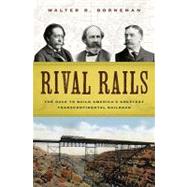
Note: Supplemental materials are not guaranteed with Rental or Used book purchases.
Purchase Benefits
| List of Maps | p. xi |
| Introduction: Railroad Battleground | p. xiii |
| Railroads and Railroaders: A Cast of Characters | p. xv |
| Major Events in Building the Southwestern Transcontinental System | p. xxi |
| Opening Gambits (1853-18740) | |
| Lines Upon the Map | p. 5 |
| Learning the Rails | p. 20 |
| An Interruption of War | p. 31 |
| Transcontinental By Any Name | p. 45 |
| The Santa Fe Joins the Fray | p. 63 |
| Straight West From Denver | p. 75 |
| "Why is it We Have So Many Bitter Enemies?" | p. 91 |
| Contested Empire (1874-1889) | |
| Showdown At Yuma | p. 109 |
| Impasse At Raton | p. 125 |
| Battle Royal for the Gorge | p. 140 |
| Handshake At Deming | p. 161 |
| West Across Texas | p. 180 |
| Transcontinental At Last | p. 194 |
| Battling for California | p. 216 |
| Gould Again | p. 230 |
| To The Halls Of Montezuma | p. 243 |
| California For A Dollar | p. 254 |
| Santa Fe All the Way (1889-1909) | |
| Making The Markets | p. 273 |
| Canyon Dreams And Schemes | p. 284 |
| The Boom Goes Bust | p. 296 |
| Still West From Denver | p. 310 |
| Top Of The Heap | p. 320 |
| Dueling Streamliners | p. 336 |
| Afterword: American Railroads in the Twenty-first Century | p. 346 |
| Acknowledgments | p. 349 |
| Notes | p. 351 |
| Bibliography | p. 583 |
| Index | p. 391 |
| Table of Contents provided by Ingram. All Rights Reserved. |
The New copy of this book will include any supplemental materials advertised. Please check the title of the book to determine if it should include any access cards, study guides, lab manuals, CDs, etc.
The Used, Rental and eBook copies of this book are not guaranteed to include any supplemental materials. Typically, only the book itself is included. This is true even if the title states it includes any access cards, study guides, lab manuals, CDs, etc.